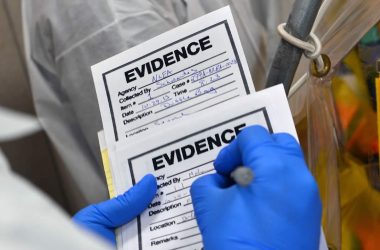CHICAGO–(ENEWSPF)–November 21, 2013. Two former water department officials for the southwest suburban Village of Crestwood were each sentenced today to two years’ probation for lying repeatedly to environmental regulators for more than 20 years about using a water well to supplement the village’s drinking water supply. The defendants, FRANK SCACCIA, a retired certified water operator, and THERESA NEUBAUER, former water department clerk and supervisor and, later, Crestwood’s police chief, effectively thwarted the government from implementing the federal Safe Drinking Water Act’s notice and testing requirements designed to ensure the safety of municipal water supplies.
In addition to probation, Scaccia, 61, of Crestwood, was ordered to serve the first six months in home confinement. He pleaded guilty on April 11 this year to making false statements. Neubauer, 56, of Crestwood, was fined $2,000 and ordered to perform 200 hours of community service. She was convicted by a jury on April 29 of 11 counts of making false statements after a week-long trial.
U.S. District Judge Joan Gottschall cited Scaccia’s serious health condition in imposing his sentence. She said the case involved a “breach of the public trust for years,” which had as its purpose “the perpetual re-election of the mayor.”
Both defendants concealed the village’s use of its well from the government and the citizens of Crestwood to save money. By doing so, the village didn’t properly monitor for contaminants that could have been introduced to Crestwood’s water supply, avoided having to fix its leaking water distribution system, or paying the neighboring Village of Alsip more money for water drawn from Lake Michigan.
“Providing safe drinking water is one of the most fundamental and important functions of local government. Those who operate municipal water systems are now on notice that defeating the Safe Drinking Water Act in exchange for selfish political and personal objectives is an extremely serious crime that will be dealt with through vigorous federal prosecution,” said Zachary T. Fardon, United States Attorney for the Northern District of Illinois.
“Public servants swear an oath to protect the citizens of their community,” said Randall Ashe, Special Agent-in-Charge of the U.S. Environmental Protection Agency’s Criminal Enforcement Program in Illinois. “Rather than protecting the citizens of Crestwood, Scaccia and Neubauer engaged in a very lengthy scheme to deny Crestwood citizens their basic right to know the source of their drinking water, and to deceive them into thinking that their drinking water was properly tested for dangerous contaminants. As a result, Crestwood residents will never fully know what contaminants from the well they ingested. This case demonstrates that anyone who violates the public trust to assure the distribution of safe, potable and properly tested drinking water will face the consequences in court.”
According to court records and the evidence at trial, since at least 1973, the substantial majority of Crestwood’s drinking water came from Lake Michigan and was purchased from neighboring Alsip, which, in turn, had purchased the water from the City of Chicago after it was treated and tested pursuant to state and federal environmental regulations. Since 1982, Crestwood regularly supplemented the Lake Michigan water with water drawn from an underground aquifer through a well located on Playfield Drive, known as Well #1. Crestwood found it necessary to supplement the Lake Michigan water with water pumped from Well #1, in part, because of substantial leakage in its water distribution system, which Crestwood officials failed to adequately repair.
Between 1987 and 2008, Scaccia, Neubauer were among of a small circle of trusted village employees ― directed by Crestwood’s longtime former mayor, Chester Stranczek, who was not charged ― who concealed that Crestwood was supplementing its Lake Michigan water with water drawn from Well #1. Scaccia was responsible for ensuring that water distributed by Crestwood met all federal and state regulations, including filing annual Consumer Confidence Reports (CCRs); obtaining the raw data that was used to complete the Monthly Operation and Chemical Analysis Reports (MORs); transmitting raw data for the MORs to Neubauer so that she could complete them and submit them to the IEPA; and serving as a point of contact for IEPA with respect to drinking water compliance issues. Neubauer prepared the CCRs for signature by Stranczek, arranged for the CCRs to be issued to Crestwood’s water customers, prepared MORs for distribution to the IEPA based upon information obtained from Scaccia, and distributed completed MORs to IEPA. All the while, Neubauer and Scaccia knew that water pumped from Well #1 was being distributed to the village’s water customers. Neubauer also helped prepare and submit various false reports stating that Well #1 was on standby status and that the sole source of Crestwood’s drinking water was Lake Michigan water purchased from Alsip.
Under the federal Safe Drinking Water Act of 1974, the U.S. EPA created regulations to ensure the safety of drinking water distributed by public water systems by requiring testing and establishing maximum contaminant levels for various contaminants. The EPA delegated the primary responsibility for enforcement to the Illinois EPA, which established its own state regulations that implemented the federal statute and regulations.
Because the City of Chicago tested and treated Lake Michigan water for contaminants, Crestwood, like other municipalities that purchased water directly or indirectly from Chicago, was excused from monitoring its Lake Michigan water for certain contaminants. Due to Crestwood’s use of Well #1, an unmonitored and unreported water source, the village should have periodically tested its drinking water for organic contaminants, inorganic contaminants, and radiological contaminants beginning in the 1970s.
Crestwood was also required to submit an Annual Water Use Audit form, known as an LMO-2 form, to the Illinois Department of Natural Resources and, previously, to the Illinois Department of Transportation. This form required Crestwood to report the amount of water it had drawn from Lake Michigan and from Well #1, and to account for the amount of water distributed and lost by its water system annually. From at least 1982 to 2008, Crestwood officials filed LMO-2 forms that neither reported the amount of water drawn from Well #1, nor accurately accounted for the amount of water distributed and lost by its water system.
The government was represented by Assistant U.S. Attorneys Erika Csicsila and Timothy Chapman, and Special Assistant U.S. Attorney Crissy Pellegrin, criminal enforcement counsel for the U.S. EPA Region V.
Source: justice.gov








